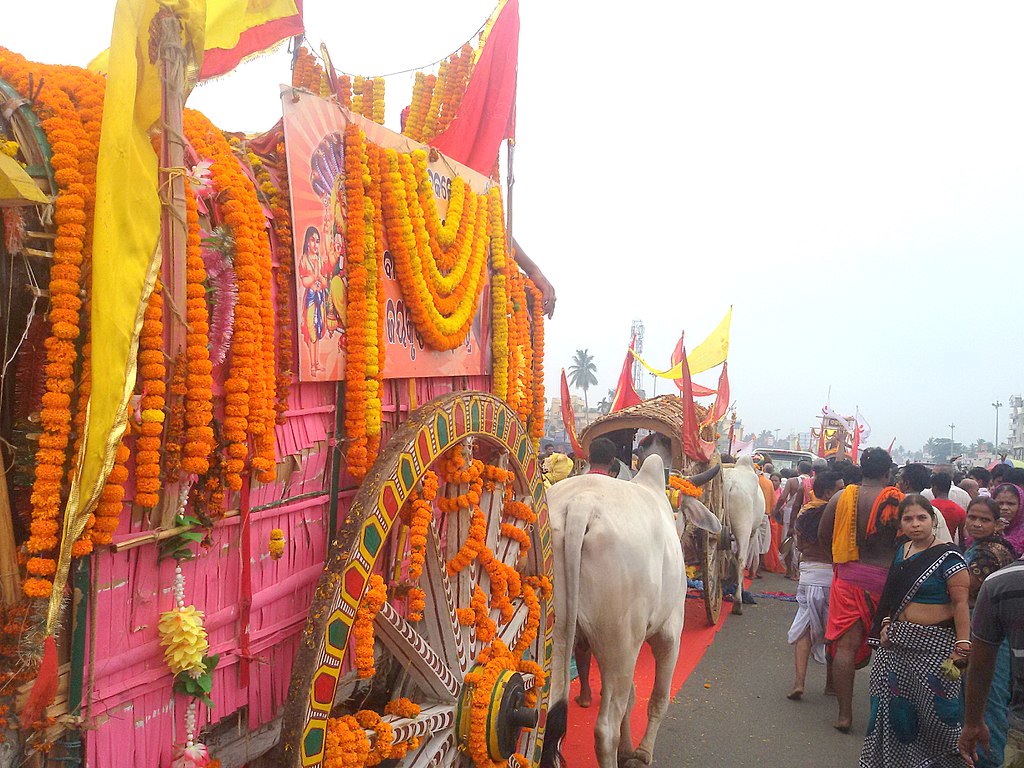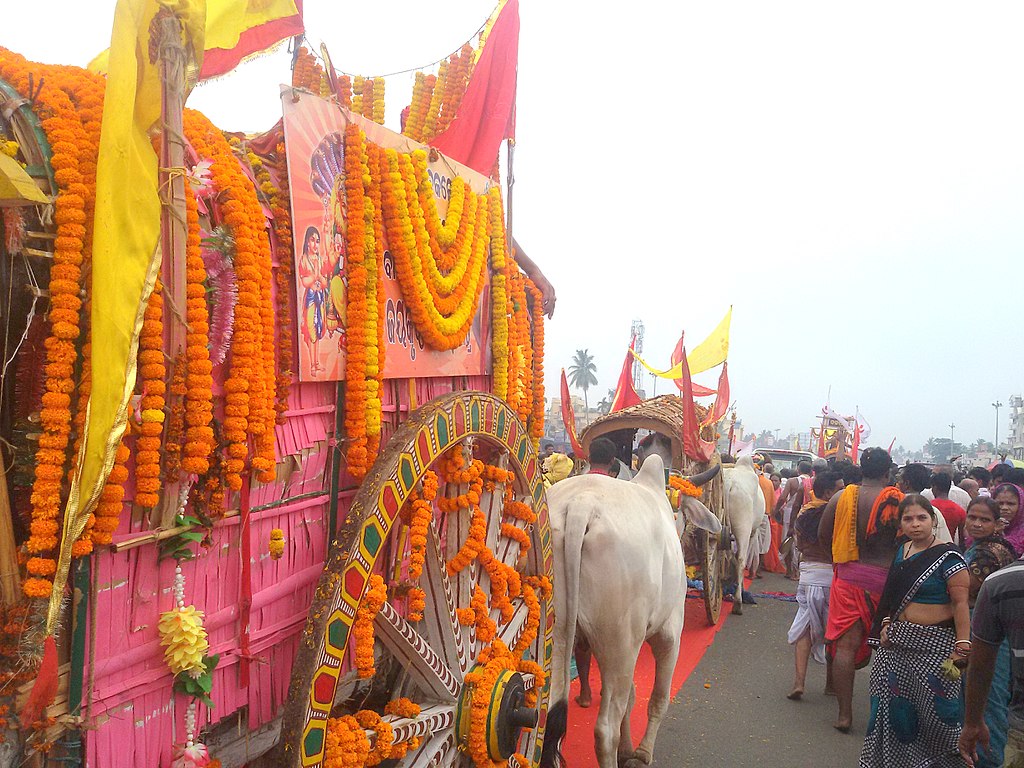The Jagannath Puri temple in Odisha celebrates Nabakalebara, a grand religious event held once in almost two decades to replace the three wooden idols of the presiding deities of the Jagannath Temple- Jagannath, Balabhadra and Subhadra. It starts in the month of Chaitra (March-April) and ends a few weeks before the Rath Yatra.
Nabakalebara is a unique ritual of ancient ‘Sanatana Dharma’ or Indian religious tradition. Although Srikshetra Puri is one among the four revered Dhams of Hinduism located in four corners of India, this distinctive ritualistic tradition is not observed anywhere else. It is because at no other place worshipped idols are made up of ‘daru’ or wood. The three idols were originally made of copper and replaced by wood in 1312.
What is Nabakalebara?
As per Indian philosophical tenets this world is manifestation of ‘Sthabara and Jangama’ or ‘Chara and Achara’ which denotes conglomeration of the animate and the inanimate. Similarly the Almighty Lord also manifests in this world in two ways. One is as Avatar like Matsya, Kachhapa, Baraha, Nrusimha, Rama etc and the other is as ‘Arccha’ or deities meant for worship.
Lord Sri Krishna tells Uddhaba- Deities are of eight types; they can be made up of stone, wood, metals like iron, silver or gold, can be created from clay or sandalwood paste, can be made up of sand, it can be mural or painting, it may be idol crafted out of precious jewel and can be the image created in one’s mind. In ‘Agni Purana’ it is mentioned that idols can be crafted from seven types of materials namely clay, wood, stone, iron, jewels, sandal and flowers.
Except the idols created through mental conception all other idols have a definite life span. They corrode with time. So, these idols have to be replaced from time to time. This is Nabakalebara or alteration of the body.
Puri Nabakalebara rituals are only meant for the idols made up of ‘Daru’ or wood. The core materials or ‘Brahma Padartha’ of old wooden idols are replaced in the new ones. Intricate essence of philosophy of body and soul described in the Srimad Bhagavad Gita is the foundation of the Nabakalebara ritual of Sri Jagannath.
‘Kalebara’ or body has been described as ‘agamapayi’ or that manifests and vanishes. Body gets created and also gets destroyed. But ‘Atma’ or soul remains intact as it is indestructible. It is eternal. In this context there is a much quoted sloka in second chapter of the Gita knows as Sankhya Yoga, “Basamsi Jirnani”.
In 1951, Dasarathi of Sambalpur had translated this famous sloka in nine syllable Odia poetic rhythm, “Tejina puruna basana, pindhila paraye nutana, e jirna deha chhadi dei, nutana deha dhare dehi”. When worshipped in this world as ‘Devata’ Sri Jagannath as an idol is also ‘Dehi’ or holder of a body. So, Sri Jagannath also sheds off His worn out body to take up a new one. Nabakalebara is a practical demonstration of this theory depicted in the Gita.
The Process
Rituals of Sri Jagannath’s Nabakalebara begin with ‘Agnyamala’. As per the tradition on Chaitra Shukla Dasami day of Indian calendar, four ‘agnyamala’ are received from the deities Sri Jagannath, Sri Balabhadra, Devi Subhadra and Sri Sudarshan to start the search of ‘daru’ for Nabakalebara.
‘Agnya’ is ‘mala’ and ‘mala’ is ‘Agnya’. Odia dictionary ‘Purna Chandra Odia Bhasakosha’ mentions- As a mark of order of any deity the garland of flowers sent to the person who will do the job is called ‘Agnyamala’. It also means garland used by the deity. This garland of flower is revered as order or directive of the deity,
Three of these are handed over to three respective ‘Badagrahi’ of Sri Jagannath, Sri Balabhadra and Devi Subhadra, who are Daitapati servitors. Descendant of Vidyapati keeps the ‘agnyamala’ of Sri Sudarshan with him. He serves as the ‘Badagrahi’ of Sri Sudarshan.

These four ‘agnyamala’ are transported to Deuli Math at Kakatpur by a bullock cart. One after another, four ‘daru vriksha’ or trees meant to be ‘daru’ are chosen and respective ‘agnyamala’ are offered to these trees. The message behind it is that identification and location of ‘daru vriksha’ for Nabakalebara is not done by the servitors who receive the ‘agnyamala’ or their associates. Sri Jagannath chooses the ‘daru’ for His own Nabakalebara. Concerned Daita and Pati Mohapatra servitors take part in this whole process only as carriers or couriers of ‘agnyamala’.
You can read our another post on Progress of Bee Keeping in Odisha
Choosing the Right Tree
‘Daru’ trees with divine symbols are selected. When a tree gets selected as ‘daru’, at first Sri Sudarshan is placed at the base of the tree. Then starts the yagna for ‘daru chhedana’ or cutting of ‘daru’.
The tree meant for the idols of Sudarshan should have three branches and the skin of the neem tree should be reddish. The tree meant for Balabhadra should have seven branches and its bark should be light-brown or white. This tree should be at a heritage site or a graveyard. The tree for the idol of Subhadra should have five branches with a yellowish bark. And finally, the tree of Jagannath should have four main branches, but of dark colour.
The tree must be in a cremation ground, with an anthill close to it, and a snake hole at its base. One interesting feature is that the tree should be near a temple of Lord Shiva. One of the most amazing requirements is,there must be natural impressions of conch-shell and chakra (wheel) on the tree trunk !
Once the trees are found, a special homa (offering to fire) is performed and the tree is cut. The artisans known as Visvakarma sculpt the wooden images,at Koili Baikuntha. During these days, a sacrifice to propitiate Lord Narsimha is performed. No priest or any other person except the artisans and carpenters are permitted inside the chamber where the idols are carved. None of the workers are allowed to eat, drink or smoke inside the chamber. In these days, the devadasis and musicians do their best to maintain a devotional atmosphere. Priests perform sacred rites to purify the pervading air.
The Brahma Parivartan (soul transfer) is the most vital ritual of the Nabakalebara (change of body) of the Sacred Trinity – Lord Jagannath, Lord Balabhadra and Devi Subhadra.
It is believed that the Brahman is a part of Lord Krishna’s physical body. After the death of Lord Krishna, Arjun alongside his other brothers cremated him in pyre. The whole body of Lord Krishna was turned to ashes, but the heart (pinda) of Krishna was still burning for years. Following a divine order, they threw the heart into the sea. It is said that this pinda or heart was seen floating as a daru (log of a tree) in the sea. King Indradyumna, who was a devoted devotee of Lord Jagannath retrieved the log.
This log since then, is called Brahman which is inside Lord Jagannath Statue.
Rules for Dayitapatis
As per the centuries-old tradition of the temple, the ‘soul’ of the deities is transferred from the old ‘daru’ (wooden) idols to the new ones by designated priests in the dead of the night.
There are different rules attached to the act that the Daitapatis must adhere to like :
The three Dayitapatis must be blindfolded.They must bind a part of Lord Jagannath’s cloth around their hands before the transfer can begin.
They should not have shaved since the first day of the search party procession. This is considered to be the disappearance ceremony of Jagannath also.
Traditionally, after a member of the family passes away, the son doesn’t shave for ten days, out of respect for the deceased. The home is also whitewashed after the death of any loved one . And since Lord Jagannath is considered to be the Head of their respective households, they are required to have their houses whitewashed after this ceremony.
The Rite
The children and all of the Dayitapati relations wear new clothes on this day of the “transfer”. This rite is taken into account to be the foremost auspicious ritual of all in Jagannath Temple.
It is this ceremony itself that’s the actual Naba Kalebar Yatra, or Transformation Ceremony of Lord Jagannath. The three Dayitapati members fast and meditate the entire day inside the temple. Only after midnight does the transfer of the “Life Force” occur, which too in total silence.
Then the old idols are buried in Koili Vaikuntha. The new idols are painted and made ready for worship.
It is with full glory and fervour that the newly made idols of Jagannath, Balabhadra, Subhadra, and Sudarshan chakra are brought inside the sanctum sanctorum of Shri Mandir. Millions of devotees gather in Puri to witness the sight of welcoming their new Lord and his siblings.
More: Wanted to download Odishashop.com visit here
In Conclusion
What’s interesting here is that nobody till date has been able to experience what this “Brahman” actually is. It cannot be seen or touched, yet it is said to be a presence of a powerful feeling in human hands.
Beyond this, exactly what this Brahman is that’s so powerfully felt, nobody is able to explain.
Nabakalebara is beautiful tradition with every process having its own intricate details that have to be taken care off, involving not a huge number of people in the process but having millions of devotees waiting for it to be carried out smoothly so that they can finally lay their eyes on Jagannath, Jagata-ra-natha (God of the World).

